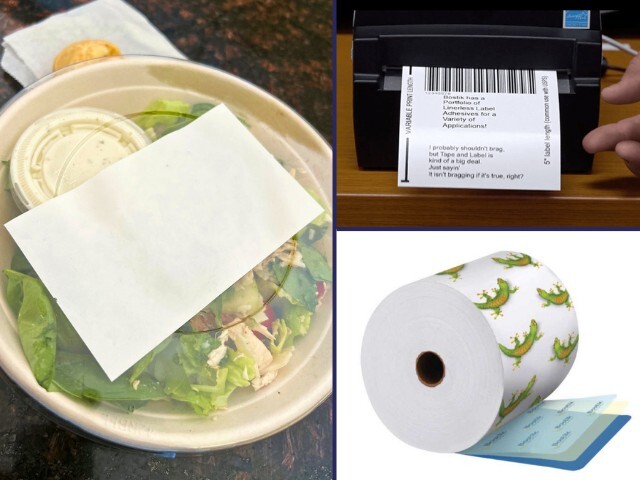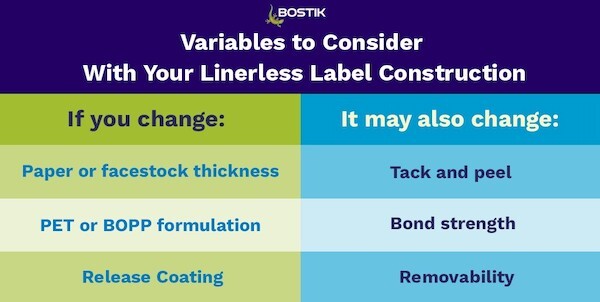
Discover the benefits of linerless label adhesives and learn key considerations for choosing the right adhesive for your specific application environment, printer requirements and label construction needs.
As a label manufacturer, you’re likely aware that linerless label adhesives, which are based on pressure sensitive adhesive technology, offer the following benefits:
- Reduced waste: Linerless label adhesives can easily unwind without adhering to themselves, which enables release liner elimination.
- Environmental stability: Due to their silicone coating, linerless label adhesives protect against chemical, UV and moisture exposure to maintain longevity for applications exposed to the environment.
- Enhanced processing: Linerless label adhesives offer low coat weights to streamline adhesive supply usage and excellent die-cut abilities to decrease production time.
However, not all linerless label adhesives are suited for all applications. Read about key considerations to make when choosing linerless label adhesive solutions to help learn which is right for you.
Consideration #1: How the Linerless Label Adhesive Performs with the Application’s Environment
While you may know what your end-use linerless label will be adhered to, it’s important to think about how that overall application is being used in various environments. This will help ensure your linerless label adhesive is supplying the right performance requirements to withstand the longevity of the application itself. For example:
Shipping or Ecommerce Applications
Your linerless label adhesive will need to withstand various environmental factors as the package is transported through different shipping stations before reaching the end user, including temperature changes and constant movement from place to place. Also, since corrugate is a common shipping/ecommerce substrate, your adhesive also may need to provide wet out for low energy surfaces to ensure a quick, secure bond. A linerless label adhesive that offers permanent and low energy surface adhesion can ensure it has the durability to minimize porosity and last throughout travel to the end user.
Grocery or Weigh Scale Applications
These applications require a linerless label to offer simple usability. This means the adhesive should move through printer rollers without sticking and offer easy cutability, allowing the end user to apply it on packaging such as a deli meat package with no problems. Further, the adhesive must be able to withstand temperature changes that often pertain to food, such as going from a room temperature printing roller to staying adhered on a cold meat package in refrigeration.
Quick-Service Restaurant Applications
These applications often include coffee cups or to-go packaging, which means the adhesive only has to sustain a short lifespan for the end users. However, in that short time frame, it still needs to sustain back-of-house efforts and movement, which may involve sudden operational or temperature changes. This means the adhesive must allow for removability without leaving residue behind and maintain performance for high temperature ranges. It's also important to know that while coffee cups and to-go packaging label adhesives must withstand high temperatures, an end-use label on a to-go package may also be used to close the bag so the end user knows their food was not tampered. This could be an important factor to consider if the end-use label needs to be a specific length for this purpose.
How to Make a Decision After Considering the Application Environment
When it comes to performance, you should choose a linerless label adhesive that can address the main environmental concerns of the end-use label and overall product. These main concerns usually include:
- Substrate versatility: Linerless label adhesives are compatible with paper, corrugate and plastic substrates, allowing them to be used in various submarkets or production lines. Further, you can incorporate linerless label adhesives into recylable packaging because the adhesive can easily wet out and spread evenly over corrugate or paper surfaces to form a strong bond.
- Removability or permanent adhesion: Linerless label adhesives are available in both removable or permanent options, ensuring your adhesive will maintain a bond to the substrate for the desired amount of time. Permanent solutions are designed to adhere even if the end-use package is moved through different environments. Removable options do not leave behind residue once repositioned or detached, allowing for enhanced aesthetics after use.
- Temperature changes: Linerless label adhesives can be formulated to meet specific temperature requirements. For example, linerless label adhesives for quick-service restaurants are designed to withstand high temperature environments, allowing them to be used in various applications from coffee cups to to-go packaging. Further, linerless label adhesives can also provide minimum application temperature, enabling it to adhere to cold-temperature products such as deli meat packaging or cold drinks.
Consideration #2: How the Linerless Label Adhesive Aligns with Printer Requirements
As mentioned above, your linerless label adhesive needs to offer easy printability, which includes moving through the direct thermal printer without sticking to rollers or cutters in the printing machinery. Further, it must not leave any residue behind that could impact how the performs; if residue is left behind, the printer may not last as long as desired. It’s important to consider how your linerless label adhesive’s performance levels should align with the end-use application’s printer requirements:
- Grocery/weigh scale printers require an adhesive to move through efficiently and adhere to packaging that may be colder or hotter than the printer’s temperature.
- Desktop/logistics printers are commonly used for shipping labels, and therefore need an adhesive that offers permanent adhesion.
- Mobile printers offer versatility to be used in various environments, which means the adhesive can offer permanent or removable adhesion depending on the application needs.
- To-go kitchen printers work fast to keep up with continuous demands. This means the adhesive needs offer repositioning capabilities for unexpected changes.
- High speed auto-supply printers are designed to move packages through a production line fast, which means the adhesive must provide quick tack to adhere efficiently through the automation process.
How to Make a Decision After Considering the Adhesive’s Printing Capabilities
When considering the right linerless label adhesive for your direct thermal printer, it is important to assess your printer’s capabilities and characteristics. For example, consider factors such as spacer widths, blades, platen roller textures and sizes, cleaning agents used and places where buildup occurs over time. By gaining an understanding of the characteristics your specific printer possesses, you can choose a linerless label adhesive that has performance capabilities intended to help you streamline printing processes and upkeep.
Further, it’s important to work with your adhesive supplier in finding the right experts to help you understand how linerless label adhesives can impact your printing capabilities. By working with a supplier that has a network of printing partners, you can ensure you’re including the right experts in your label manufacturing to provide high end-use performance.
Consideration #3: How the Adhesive Works with Other Linerless Label Layers
It’s critical to understand how each label layer plays a role with the adhesive to ensure the right materials are chosen to accomplish your performance needs. Along with the adhesive, this includes addressing:
- Facestock: It's important to know whether your facestock can remain adhered for long periods of time or if it can maintain aesthetics once removed, as this could impact its environment resistance levels.
- Top coating: Serving as a silicone release on the other side of the facestock, the top coating should be able to prevent the adhesive from sticking to its backside on a linerless roll. Along with the performance, you should determine whether you have the equipment to apply the top coating in house or need to outsource facestock that includes silicone from a supplier.
To ensure these layers work together efficiently, multiple tests may need to be conducted to determine the right formulations, including tack and peel resistance. Testing these abilities determines if the adhesive can perform properly when bonded to the substrate. This is particularly useful to test on your desired facestock; once you know whether the facestock is with the chosen linereless label adhesive, you will need to test different coat weights to understand how the substrate reacts to the thickness. For example, corrugate typically requires a higher tack so it receives the necessary wet out for strong adhesion, whereas plastic often requires less tack to bond properly.
Further, it’s critical to continue testing if any variable is changed in your label construction in the future. As the chart below outlines, changing one variable can impact others, and result in poor performance.

How to Make a Decision After Considering the Label Layers
Relying on one supplier for your linerless label materials can help you make the right decisions on your formulations for the adhesive, facestock and top coating, ensuring the layers are working together effectively for high end-use performance. A supplier that provides solutions and expertise for linerless label construction can provide the following capabilities:
- Customized formulations: Whether you’re constructing your linerless label construction or switching out one variable to meet a performance need with the end-use application, a reliable, sole supplier can help you see how every layer will work together to provide the specifications you want.
- Technical support: A reliable supplier will provide you with a team of experts who can help you throughout the entire process of your linerless label manufacturing:
- In-house testing: The supplier will work with you to test samples you’re considering for your label construction and provide recommendations on what could be the most efficient for your production equipment. Further, the supplier will have their own pilot coating equipment, allowing you to conduct trials without pausing your day-to-day operations.
- Troubleshooting: The supplier will be there to help you through any setbacks while producing the finished linerless label on your own equipment, offering recommendations on what may be causing problems or how to improve production efficiencies.
How Bostik Can Help You Choose the Right Linerless Label Adhesive
As the adhesive solutions division of Arkema, Bostik offers a large portfolio of linerless label adhesive solutions, allowing you to choose a formulation that is right for your specific needs. Additionally, our team of experts can provide the technical service for customized formulations, trialing and troubleshooting support. Designed for shipping and ecommerce, grocery or weigh scale and quick service restaurant applications, our linerless label adhesives offer:
- Permanent or removable solutions: Our linerless label adhesives yield strong bonds for permanent applications or offer repositioning capabilities without leaving residue behind.
- Temperature stability: We offer solutions that are formulated to bond at low to ambient temperatures while also withstanding high temperature environments, ensuring the end-use linerless label will provide adhesion in various environments.
- Substrate versatility: Compatible with corrugate, glass and paper substrates, our linerless label adhesives can adhere to low energy surfaces, enabling you to utilize more recycled content with short fibers.
- Processing efficiencies: Our linerless label adhesives provide quick tack and wet out for fast adhesion, making them easy to incorporate into auto-apply and sortation processes.
Are you ready to choose the right adhesive solution for your linerless label manufacturing? Contact a Bostik expert to learn how we can help you make the right decision for your application requirements.
Other relevant content:
Bostik Spotlight Q&A: Technical Support to Improve Sustainability
©2023 Bostik, Inc. All Rights Reserved
All information contained herein is believed to be accurate as of the date of publication, is provided “as-is” and is subject to change without notice. To review our full U.S. Legal Disclaimer, visit: https://bostik.com/us/en_US/privacy-policy/legal-disclaimer
